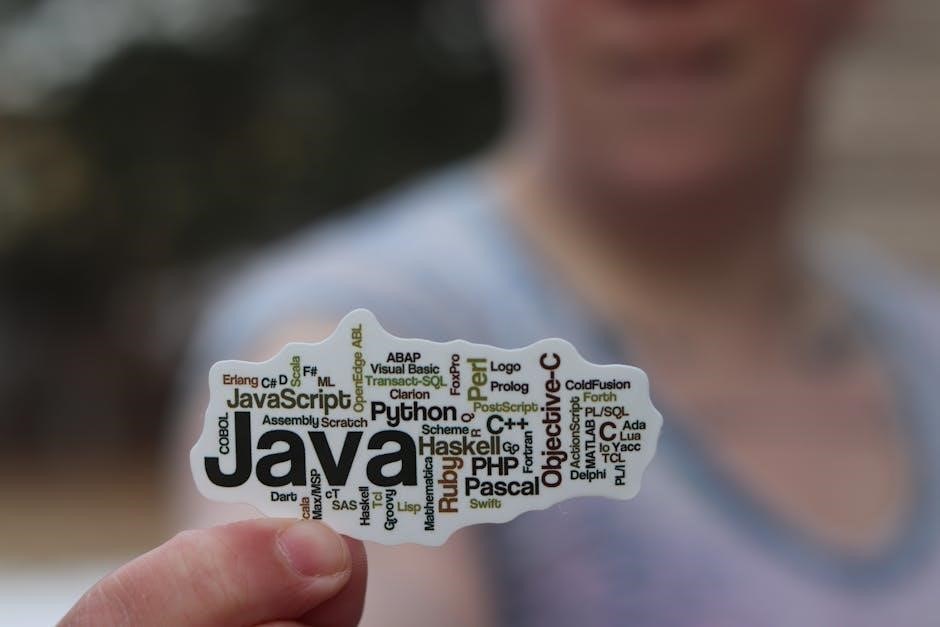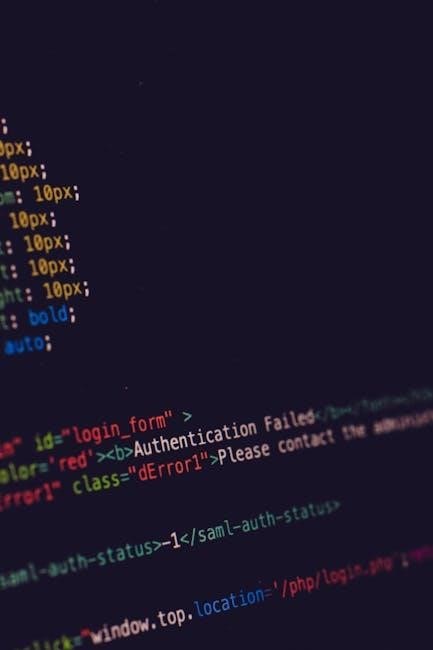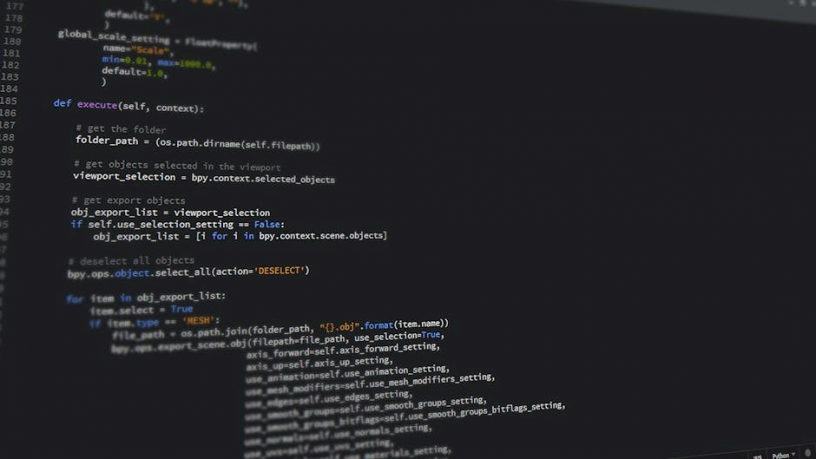resources provide a comprehensive guide for beginners, covering essential concepts, syntax, and object-oriented principles. These materials are ideal for those new to programming, offering clear explanations and practical examples to build a strong foundation in Java development. The resources often include exercises and real-world applications to enhance learning and prepare for advanced topics.
1.1 What is Java?
Java is a high-level, object-oriented programming language developed by Sun Microsystems (now Oracle). Known for its platform independence, Java follows the “write once, run anywhere” principle, enabling programs to run on any device with a Java Virtual Machine (JVM). Created in 1995, Java is widely used in web, mobile, and enterprise applications due to its simplicity, scalability, and robust security features. Its platform-independent nature and extensive libraries make it a popular choice for developers and learners alike.
1.2 Why Learn Java?
Java is a top choice for programming due to its platform independence, allowing “write once, run anywhere” functionality. Its simplicity, robust security, and vast ecosystem make it ideal for beginners and experienced developers. Java powers applications in web, mobile, and enterprise environments, offering versatility and scalability. With a large community and extensive libraries, Java simplifies development. Learning Java opens doors to Android app development, game creation, and IoT projects, making it a valuable skill for career growth in the ever-evolving tech industry.

History and Evolution of Java
Java was created by James Gosling at Sun Microsystems in 1995, initially called Oak. It evolved to become a platform-independent language, with continuous updates improving functionality and performance.
2.1 The Creation of Java
Java was created in 1995 by James Gosling at Sun Microsystems, initially named Oak. The project aimed to develop a platform-independent language for consumer electronics. Renamed Java in 1995, it was designed with core principles like “Write Once, Run Anywhere.” The first public release, Java 1.0, focused on simplicity, robustness, and platform independence, laying the foundation for its widespread adoption in software development.
2.2 Major Versions and Updates
Java has evolved significantly since its first release in 1996. Notable versions include Java 5, which introduced generics and autoboxing, and Java 8, known for lambdas and the Stream API. Java 11 added var for local variables and HTTP Client, while Java 17 brought sealed classes and pattern matching. These updates have enhanced performance, security, and developer productivity, ensuring Java remains a leading language for modern applications.
Setting Up the Development Environment
Setting up a Java development environment involves installing the JDK, selecting an IDE like IntelliJ IDEA or Eclipse, and configuring the command line interface. This setup enables developers to start coding and building Java applications effectively.
3.1 Installing Java SE Development Kit (JDK)
Installing the Java SE Development Kit (JDK) is the first step in setting up a Java development environment. Visit Oracle’s official website to download the latest JDK version suitable for your operating system. Ensure your system meets the minimum requirements before installation. Follow the installation wizard’s instructions to complete the setup. After installation, configure the environment variables, such as PATH and JAVA_HOME, to ensure Java commands are recognized in the command line. Verify the installation by running java -version in the terminal. The JDK includes essential tools like the Java compiler and runtime environment, enabling developers to create and execute Java programs.
3.2 Choosing an Integrated Development Environment (IDE)
Selecting the right Integrated Development Environment (IDE) is crucial for efficient Java programming. Popular choices include Eclipse, NetBeans, and IntelliJ IDEA. These IDEs offer features like code completion, debugging tools, and project management. Eclipse and NetBeans are free and open-source, making them ideal for beginners. IntelliJ IDEA provides advanced functionality and is widely used in professional settings. Choose an IDE that aligns with your learning style and project requirements to enhance productivity and streamline the development process.
3.3 Configuring the Command Line Interface
Configuring the Command Line Interface (CLI) is essential for compiling and running Java programs. Start by setting the PATH and CLASSPATH environment variables to include the JDK’s bin and lib directories. Verify the setup by typing java -version in the terminal. Create a simple Java program, save it with a .java extension, and compile it using javac. Run the program with java followed by the class name. This setup allows you to develop and test Java applications efficiently without an IDE, ensuring a strong foundation for programming fundamentals.

Basic Syntax and Data Types
Java’s syntax is based on C, making it familiar to many programmers. Primitive data types like int and boolean store basic values, while variables hold these values for operations.
Java syntax is based on C, making it familiar to many programmers. A Java program starts with a class declaration, followed by the main method. Statements end with semicolons, and code blocks are enclosed in curly braces. Variables are declared with specific data types, and control flow is managed using if-else statements, for, while, and do-while loops. Proper indentation enhances readability, and comments explain code logic. Understanding Java syntax is foundational for writing correct and efficient programs.
4.2 Primitive Data Types
Primitive data types in Java are the basic building blocks for variables. Common types include int for integers, double for floating-point numbers, boolean for true/false values, and char for single characters. Each type has a fixed size, ensuring consistent behavior across systems. Primitive types are stored in memory as raw values, making them faster and more efficient than reference types. Understanding these types is essential for effective Java programming, as they directly impact memory usage, performance, and code clarity.
4.3 Variables and Data Types
In Java, variables are named storage locations that hold values. Each variable must be declared with a specific data type, which determines the type of value it can store and the operations it can perform. Data types include primitive types like int, double, and boolean, as well as reference types like String. Properly declaring variables ensures type safety and efficient memory usage. Understanding how to work with variables and their data types is fundamental for writing clear and effective Java programs, as they form the basis of all computations and data manipulation.

Control Flow in Java
Control flow in Java determines the order of program execution, enabling decision-making and repetition. It includes conditional statements like if-else and loops such as for, while, and do-while. Mastering control flow is essential for creating dynamic and responsive applications, as it allows programs to adapt based on user input, data conditions, or iterative processes. Understanding these constructs is crucial for managing program logic effectively and writing robust Java code.
5.1 Conditional Statements
5.2 Loops in Java
5.3 Switch Statements
statements effectively.

Object-Oriented Programming Concepts
6.1 Classes and Objects
6.2 Constructors and Methods
6.3 Inheritance and Polymorphism

Advanced Java Programming Concepts
Explore advanced topics like arrays, exception handling, and file I/O. Learn efficient memory management and multi-threading. These concepts enhance problem-solving skills and application development in Java.
7.1 Arrays and Data Structures
In Java, arrays and data structures are fundamental for organizing and manipulating collections of data. Arrays store elements of the same type in a fixed-size container, enabling efficient access and modification. Data structures like lists, stacks, and queues provide dynamic ways to handle collections. Understanding these concepts is crucial for building scalable applications, as they allow for efficient memory management and algorithm implementation. Practical examples, such as using ArrayList for dynamic lists, demonstrate how to leverage these tools effectively in real-world programming scenarios.
7.2 Exception Handling
Exception handling in Java is a mechanism to manage runtime errors gracefully, ensuring smooth program execution. It uses try, catch, and finally blocks to encapsulate code, handle exceptions, and release resources. Specific exceptions can be caught, allowing for precise error management. Additionally, the throw keyword enables manual exception propagation. Proper exception handling enhances code robustness and user experience by providing meaningful error messages and preventing abrupt program termination.
Best practices include handling specific exceptions, avoiding generic catches, and logging errors for debugging. The finally block ensures resource cleanup, regardless of exceptions. Mastering this concept is essential for writing reliable and maintainable Java applications.
7.3 File Handling and Input/Output
Java provides robust mechanisms for file handling and input/output operations, enabling developers to interact with external data sources. The File and FileReader/FileWriter classes simplify file operations, while streams like InputStream and OutputStream handle binary data. The Scanner class facilitates parsing input from various sources, such as files or user input. Practical applications include reading text files, writing logs, and handling user inputs. Best practices involve using try-with-resources for automatic resource management, ensuring efficient and error-free file handling in Java applications.

Practical Applications and Projects
Java’s versatility is showcased in real-world applications, from web development to mobile apps. Learners can build projects like calculators, to-do lists, and e-commerce platforms, applying core concepts.
8.1 Building Simple Applications
Building simple applications is a cornerstone of learning Java, allowing beginners to apply theoretical concepts to practical problems. Tutorials and PDF guides often include step-by-step instructions for creating basic programs, such as calculators, to-do lists, or chat applications. These exercises help developers understand Java syntax, variables, and control flow while fostering problem-solving skills. By starting with simple projects, learners can gradually build confidence and move on to more complex tasks, solidifying their foundation in Java programming.
- Practice with command-line tools.
- Implement basic user interfaces.
- Explore data handling and input/output operations.
8.2 Real-World Projects
Engaging in real-world projects is essential for mastering Java programming. These projects, often highlighted in PDF guides, allow learners to apply concepts like object-oriented design, data structures, and exception handling to practical scenarios. Examples include building Android apps, web applications, or desktop tools. Such projects enhance problem-solving skills, familiarize developers with industry standards, and prepare them for professional environments. They also demonstrate how Java’s versatility and scalability make it a preferred choice for diverse applications.
- Android app development.
- Web applications using Java frameworks.
- Desktop tools and utilities.
8.3 Best Practices for Coding
Adhering to best practices in Java programming ensures readable, maintainable, and efficient code. PDF guides emphasize practices like using meaningful variable names, following Java naming conventions, and structuring code logically. Developers should also focus on modularizing functions, handling exceptions gracefully, and documenting code thoroughly. Additionally, leveraging Java’s built-in libraries and frameworks can streamline development. By adopting these practices, programmers can write cleaner, more scalable code, reducing errors and enhancing collaboration in team environments.
- Use clear and descriptive variable names.
- Follow Java naming conventions.
- Modularize code for reusability.
- Implement robust error handling.
- Document code for better understanding.

Resources and References
by Y. Daniel Liang and online tutorials from Oracle. Communities like GitHub and forums offer additional support and code examples.
9.1 Recommended Textbooks
provides an accessible, interdisciplinary approach. Herbert Schildt’s Java: A Beginner’s Guide is a practical introduction, updated for Java SE 17. These books are ideal for beginners and experienced programmers, emphasizing problem-solving and object-oriented concepts. They offer clear explanations, exercises, and real-world applications, making them essential resources for mastering Java programming.
9.2 Online Tutorials and Guides
by David J. Eck is a free online textbook. Oracle’s official Java EE Tutorials offer detailed guides for web and enterprise development. Tutorials on platforms like GitHub, such as JAVA-SE-Tutorial-codeswithpankaj, provide practical code examples. These resources cover topics from basic syntax to advanced concepts, catering to both beginners and experienced programmers. They often include exercises, examples, and real-world applications to enhance learning effectiveness.
9.3 Community and Forums
Engaging with Java programming communities and forums is essential for learning and troubleshooting. Platforms like Stack Overflow and Reddit’s r/learnjava offer valuable discussions and solutions. The Oracle Java Forums provide official support, while GitHub hosts communities like JAVA-SE-Tutorial-codeswithpankaj. These spaces allow developers to share knowledge, resolve issues, and gain insights from experienced programmers. Active participation in these forums enhances problem-solving skills and fosters a supportive environment for both beginners and advanced developers to grow and collaborate effectively.
10.1 Summary of Key Concepts
resources, learners master syntax, variables, loops, and conditional statements. These materials emphasize problem-solving techniques and practical applications, providing a solid foundation for advanced topics. By understanding classes, objects, and methods, developers can create robust, scalable applications. These resources ensure a comprehensive grasp of Java fundamentals, preparing learners for real-world programming challenges and further exploration of the language.
10.2 Continuing Learning
resources often provide pathways to intermediate and advanced topics, ensuring a smooth transition. Practicing with real-world projects and contributing to open-source initiatives enhances proficiency. Engaging with online communities, forums, and tutorials fosters continuous improvement. Experimenting with code and staying updated with Java’s latest versions and features ensures long-term growth in programming skills and expertise.

Frequently Asked Questions (FAQs)
Common questions about Java programming include fixing syntax errors, understanding null pointer exceptions, and best practices for learning Java. Resources like tutorials and forums provide solutions.
11.1 Common Errors and Solutions
When learning Java, common errors include syntax mistakes, null pointer exceptions, and incorrect use of data types. Solutions involve checking code syntax, initializing variables properly, and understanding exception handling. Resources like debuggers and online forums help identify and fix issues. Properly managing classpaths and ensuring correct imports are also essential for resolving compilation errors. Practicing with simple programs and reviewing error messages can improve troubleshooting skills and enhance overall programming efficiency in Java.
11.2 Troubleshooting Tips
Troubleshooting in Java involves identifying and resolving errors efficiently. Start by carefully reading error messages to understand the issue. Use debugging tools like Eclipse’s Debugger or IntelliJ IDEA to step through code and inspect variables. Verify that classpaths are correctly set and libraries are properly imported. Test individual components to isolate problems. Utilize online forums and documentation for solutions to common issues. Practice debugging exercises to improve problem-solving skills and enhance coding efficiency. Regularly reviewing code and maintaining clean syntax can prevent many errors from occurring.

Glossary of Terms
A comprehensive glossary of Java programming terms is essential for understanding key concepts. Terms like Object-Oriented Programming (OOP) refer to organizing software design around objects and classes. Primitive Data Types include basic types like int, char, and boolean. Methods are blocks of code performing specific tasks, while Constructors initialize objects. Inheritance allows classes to inherit properties from parent classes. Polymorphism enables methods to perform differently based on context. Understanding these terms is crucial for mastering Java programming effectively.




Leave a Reply
You must be logged in to post a comment.